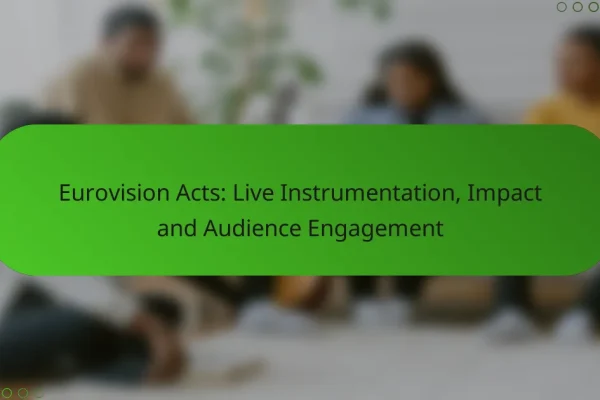What are the best Eurovision Song Contest performances of all time?
The best Eurovision Song Contest performances are often defined by their impact, vocal strength, and memorable staging. Iconic acts like ABBA and Celine Dion have left a lasting legacy, while more recent entries like Loreen’s “Euphoria” showcase the evolving nature of the competition.
ABBA – “Waterloo” (1974)
ABBA’s performance of “Waterloo” in 1974 is frequently cited as one of the most significant moments in Eurovision history. Their catchy tune and charismatic stage presence won the contest and launched their international career, making them household names.
The song’s upbeat tempo and engaging lyrics set a standard for future entries, combining pop sensibilities with a theatrical flair. “Waterloo” remains a beloved classic, often performed at various events and celebrations across Europe.
Celine Dion – “Ne Partez Pas Sans Moi” (1988)
Celine Dion’s “Ne Partez Pas Sans Moi” won the Eurovision Song Contest in 1988, marking a pivotal moment in her career. The powerful ballad showcased her exceptional vocal talent and emotional delivery, captivating both the audience and judges.
This performance not only secured her victory but also paved the way for her future success in the music industry. Dion’s ability to connect with the audience through her heartfelt rendition has made this performance a memorable highlight in Eurovision history.
Loreen – “Euphoria” (2012)
Loreen’s “Euphoria” won the Eurovision Song Contest in 2012 and is often regarded as a modern classic. The song’s blend of electronic pop and powerful vocals, combined with a visually stunning performance, resonated with viewers across Europe.
“Euphoria” set a new benchmark for contemporary entries, influencing the sound and style of subsequent performances. Its success demonstrated the importance of both musicality and visual presentation in capturing the audience’s attention at Eurovision.
How do Eurovision performances impact voting?
Eurovision performances significantly influence voting outcomes by captivating the audience and creating memorable experiences. Factors such as visual appeal and stage presence play crucial roles in how viewers perceive and ultimately vote for their favorite acts.
Visual appeal influences audience votes
Visual elements, including costumes, lighting, and set design, greatly affect how performances are received. A striking visual presentation can capture attention and enhance emotional engagement, leading to higher vote counts. For example, performances that incorporate vibrant colors and dynamic staging often resonate more with the audience.
To maximize visual appeal, performers should consider using bold costumes and innovative staging techniques. Keeping the design cohesive with the song’s theme can further strengthen the connection with viewers. Avoid cluttered visuals that may distract from the performance itself.
Stage presence enhances performer ratings
Stage presence is vital for creating a connection with the audience and boosting performer ratings. Charismatic performers who engage with the crowd and convey strong emotions tend to leave a lasting impression. This can lead to increased support and votes from viewers.
To improve stage presence, artists should practice their movements and expressions to ensure they appear confident and relatable. Interacting with the audience, whether through eye contact or gestures, can also enhance the overall experience. Avoiding overly rehearsed or robotic performances is crucial, as authenticity resonates more with viewers.
What are the key elements of a successful Eurovision performance?
A successful Eurovision performance hinges on strong vocal delivery, engaging choreography, and creative staging and visuals. These elements work together to captivate the audience and judges, making a memorable impact that can lead to higher scores and viewer votes.
Strong vocal delivery
Strong vocal delivery is essential for any Eurovision entry, as it showcases the artist’s talent and emotional connection to the song. Performers should aim for clarity, pitch accuracy, and the ability to convey the song’s message effectively. Regular vocal training and practice can help artists maintain their vocal strength during live performances.
To enhance vocal delivery, consider incorporating vocal warm-ups and exercises before the performance. Additionally, using a microphone that suits the singer’s voice can significantly improve sound quality. Avoid overexerting the voice during rehearsals to prevent strain.
Engaging choreography
Engaging choreography adds a dynamic visual element to a Eurovision performance, drawing in viewers and enhancing the overall experience. Choreography should complement the song’s mood and tempo, with movements that are easy to follow yet impactful. A well-rehearsed dance routine can elevate a performance from good to unforgettable.
When planning choreography, focus on creating memorable moments that highlight key parts of the song. Collaborating with experienced choreographers can help in developing routines that resonate with audiences. Ensure that performers are comfortable with the choreography to maintain energy and enthusiasm on stage.
Creative staging and visuals
Creative staging and visuals play a crucial role in setting the atmosphere for a Eurovision performance. This includes the use of lighting, props, and backdrops that align with the song’s theme. A visually striking performance can capture attention and leave a lasting impression on both the audience and judges.
To achieve effective staging, consider using a mix of colors and textures that enhance the performance’s emotional tone. Incorporating multimedia elements, such as video projections or special effects, can also add depth. It’s important to ensure that the staging does not overshadow the performers but instead complements their talents.
How has the Eurovision performance style evolved over the years?
The Eurovision performance style has significantly changed, reflecting broader cultural trends and advancements in technology. Over the decades, performances have transitioned from simple stage setups to elaborate productions featuring intricate choreography, visual effects, and diverse musical influences.
Increased use of technology
Technology has transformed Eurovision performances, with artists now utilizing advanced lighting, sound systems, and multimedia displays. This shift allows for more engaging and visually stunning presentations, enhancing the overall viewer experience.
For instance, many recent performances incorporate LED screens and digital backdrops, which can change dynamically throughout the song. This creates a more immersive atmosphere, captivating audiences both in the venue and at home.
Shift towards diverse musical genres
In recent years, Eurovision has embraced a broader array of musical genres, moving beyond traditional pop to include elements of rock, hip-hop, and folk music. This diversity reflects the changing tastes of audiences and allows for a richer competition.
Countries now often showcase their cultural heritage through music, blending local styles with contemporary sounds. For example, entries from Eastern Europe frequently incorporate traditional instruments, while Western nations may experiment with electronic beats, appealing to a wider demographic.
What are the common themes in Eurovision performances?
Eurovision performances often center around themes of unity, celebration, and social or political messages. These elements resonate with audiences, creating a shared experience that transcends cultural boundaries.
Celebration of unity
The Eurovision Song Contest is a vibrant showcase of cultural diversity, where performances frequently highlight the theme of unity among participating nations. Artists often incorporate elements from their cultural heritage, using music and dance to foster a sense of togetherness.
For example, many performances feature multilingual lyrics or collaborations between artists from different countries, emphasizing cooperation and friendship. This celebration of unity is not only entertaining but also promotes a message of peace and solidarity across Europe.
Social and political messages
Many Eurovision entries convey social and political messages, reflecting contemporary issues that resonate with audiences. Artists often use their platform to address topics such as [censured] rights, environmental concerns, and social justice, making their performances more than just entertainment.
For instance, some performances may include visual elements or lyrics that advocate for change, sparking conversations among viewers. This blend of art and activism can enhance the emotional impact of a performance, encouraging audiences to engage with important societal issues.
How do different countries prepare for Eurovision performances?
Countries prepare for Eurovision performances through a combination of national selection competitions and collaboration with professional teams. These processes help ensure that the chosen acts are well-prepared and competitive on the international stage.
National selection competitions
National selection competitions are the primary method by which countries choose their Eurovision representatives. These competitions can take various forms, including televised contests, internal selections, or a combination of both. For example, countries like Sweden use a well-structured format called Melodifestivalen, which involves multiple rounds and public voting.
Each country typically announces its selection process several months in advance, allowing artists to submit their entries. The selection criteria often include originality, performance quality, and public appeal, ensuring that the chosen act resonates with both national and international audiences.
Collaboration with professional teams
Collaboration with professional teams is crucial for a successful Eurovision performance. Artists often work with songwriters, choreographers, and vocal coaches to refine their acts. This collaboration helps enhance the overall quality of the performance, from the song’s composition to the staging and choreography.
Many countries invest in experienced production teams to create visually stunning performances. For instance, staging elements such as lighting, costumes, and special effects are meticulously planned to captivate the audience. Engaging with professionals can significantly increase a country’s chances of success at Eurovision.
What are the most memorable staging techniques used in Eurovision?
Memorable staging techniques in Eurovision often include dramatic visual elements that enhance the performance and captivate the audience. These techniques can significantly influence the overall impact of a song, making it stand out in a highly competitive environment.
Use of pyrotechnics
Pyrotechnics are a popular choice in Eurovision performances, adding excitement and visual flair. Fireworks, flames, and spark effects can create a powerful atmosphere, especially during climactic moments of a song.
When incorporating pyrotechnics, it’s essential to consider safety regulations and venue restrictions. Many countries have specific guidelines regarding the use of fire and explosives, so performers must ensure compliance to avoid penalties.
Innovative lighting designs
Innovative lighting designs play a crucial role in enhancing the mood and theme of a performance. Dynamic lighting can change colors, patterns, and intensities, helping to convey emotions and highlight key moments in the song.
Effective lighting design often involves synchronized effects that match the music’s rhythm. Performers should collaborate closely with lighting technicians to create a cohesive visual experience that complements their artistic vision.
What role does fashion play in Eurovision performances?
Fashion plays a crucial role in Eurovision performances by enhancing the visual appeal and reinforcing the artist’s message. Costumes can create memorable impressions, influence audience engagement, and contribute to the overall storytelling of a performance.
Impact on audience perception
The way performers dress can significantly shape audience perception. Bold and unique outfits often attract attention, making the act more memorable. For instance, striking colors or avant-garde designs can evoke emotions and create a lasting impression, which is essential in a competition where many acts vie for attention.
Trends and cultural representation
Fashion in Eurovision often reflects current trends and cultural elements from the performers’ home countries. Artists may incorporate traditional attire or modern styles to showcase their heritage, creating a connection with both local and international viewers. This blend of contemporary and cultural fashion can enhance the narrative of the performance.
Strategic costume choices
When selecting costumes, performers should consider how their outfits will complement the music and choreography. Costumes should allow for freedom of movement while also being visually striking under stage lights. It’s advisable to avoid overly complex designs that may distract from the performance or hinder movement.







